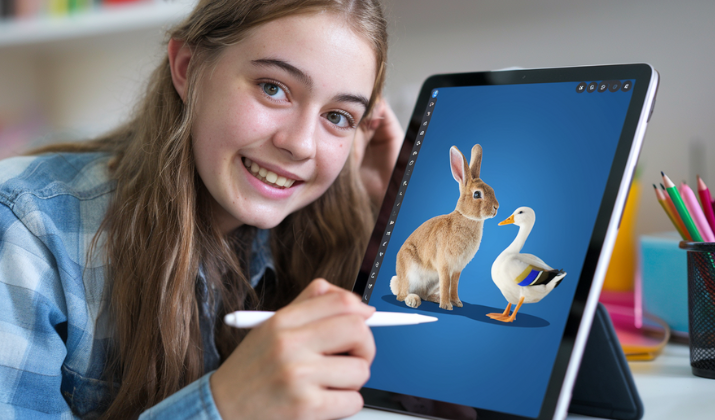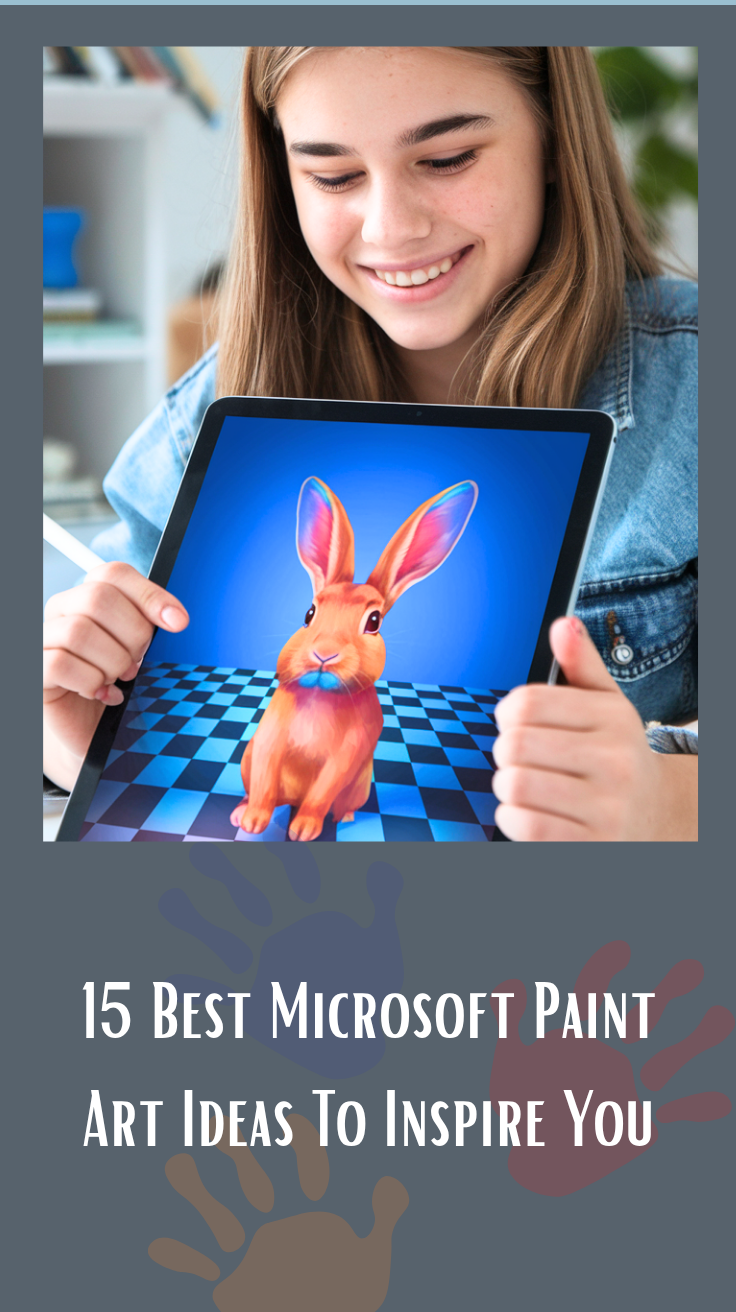Who says great art requires fancy software?
Microsoft Paint may look simple at first glance, but it’s actually a creative goldmine if you know how to use it right.
From nostalgic pixel drawings to mesmerizing digital landscapes, there’s no shortage of ways to turn your imagination into colorful visuals using just your mouse (or trackpad!).
Whether you’re a beginner trying to doodle for fun or someone looking to master the art of minimal digital expression, MS Paint can be surprisingly rewarding. Its limitations often spark more creativity than you’d expect.
In this list, we’ll dive into some of the best Microsoft Paint art ideas that artists of all levels can explore.
So grab that pencil tool, zoom in, and let’s get inspired!
Best Microsoft Paint Art Ideas To Inspire You
1. Pixel Landscapes
Pixel landscapes are perfect for MS Paint because the software’s blocky precision lends itself beautifully to pixel-based art.
Start small with mountains, lakes, or rolling hills, and build your scene square by square. Experiment with gradients to mimic light and shadow, which can give your image more depth.
It’s amazing how much emotion and atmosphere you can create with just a few hundred pixels.
Try blending natural elements with fantasy touches like glowing waterfalls or floating islands. You’ll quickly find that pixel landscapes are addictive to build once you get into the rhythm.
The best part? They double as nostalgic tributes to old-school video game backgrounds. Every click feels like you’re building a world from scratch.
2. Minimalist Portraits
Minimalist portraits are all about simplicity, clean lines, and bold color blocks.
In MS Paint, you can create stunning portraits by focusing on essential shapes and contours rather than intricate details.
Start by outlining the face using the pencil tool and fill in broad areas with flat colors. Play with proportions to give your piece a stylized edge, it doesn’t need to look realistic to be impactful.
Think of it like digital pop art but stripped down to its core essence. The limited toolset in Paint actually helps you avoid overcomplicating your design.
These portraits look fantastic when paired with bright backgrounds or abstract patterns. It’s a brilliant way to express personality through simplicity.
3. Abstract Geometric Art
MS Paint’s shape tools are perfect for geometric experimentation.
Circles, rectangles, triangles, you name it, can be combined in endless ways to make bold abstract art.
Use layers of transparent shapes to create overlapping color blends that give your work a sense of motion.
You can even experiment with symmetry for a more structured aesthetic or go freestyle for a chaotic vibe.
The magic of geometric abstraction lies in how random designs often turn into something unexpectedly beautiful.
Try working with a limited color palette for a modern, poster-like finish.
It’s fun, easy to start, and surprisingly meditative once you get into the flow. Plus, geometric art always looks clean and polished, even in Paint.
4. Digital Collages
Who says you can’t make a collage in MS Paint?
You totally can, just think digital! Combine cut-out elements, textures, and random doodles to create a layered, scrapbook-style masterpiece.
Copy and paste sections of your own artwork, then overlap and resize them for a dynamic look.
You can mix pixel textures with flat illustrations to add contrast. The eraser and fill tools become your best friends when cleaning up edges or blending colors.
Collages are great for storytelling because each section can represent a different emotion or theme. Try creating mood boards or dreamscapes where imagination runs wild. It’s organized chaos at its most artistic.
5. Pixel Animals
Creating pixel animals in MS Paint is an adorable and rewarding challenge.
Because of the pixelated format, even simple creatures like cats, fish, or birds take on a charming retro look.
Start with a small canvas so each pixel feels deliberate and meaningful. Outlining with darker shades before filling in colors helps the shapes pop.
You can go for realism or stylized cuteness, both work great! Try animating a few frames to bring your critter to life.
It’s a wonderful project for beginners because it teaches patience and precision. And when you zoom out, seeing your tiny digital zoo come alive is incredibly satisfying.
6. Surreal Dreamscapes
MS Paint might seem too simple for surrealism, but that’s what makes it magical. Surreal dreamscapes thrive on blending ordinary elements in extraordinary ways.
Picture floating clocks, trees growing from teacups, or cities inside raindrops. Use Paint’s layering and transparency options creatively to merge images seamlessly.
Don’t worry about perfect realism, the weirder, the better! Surreal art invites you to explore your imagination freely without any pressure to follow logic.
Every brushstroke can spark a story or emotion. Once you finish, you’ll be amazed at how Paint can turn something bizarre into something deeply poetic.
7. Pixel Game Characters
If you’ve ever dreamed of designing your own video game hero, MS Paint is the perfect place to start.
Create a tiny grid-based character with distinct features, outfits, or weapons. Think old-school RPG sprites or classic platformer designs.
Paint’s pixel-perfect precision makes it easy to test out different color schemes and facial expressions.
You can even draw multiple poses, standing, walking, jumping, to mimic animation frames. Try making villains, sidekicks, and even NPCs to populate your mini world.
It’s a fantastic blend of art and game design that hones your creative discipline. Plus, it’s incredibly nostalgic for anyone who grew up with 8-bit games.
8. MS Paint Self-Portrait
Challenge yourself by creating a self-portrait entirely in MS Paint.
You don’t need realism, just your own interpretation. Start with a simple outline, block in skin tones, and add your signature features like hair, glasses, or a favorite accessory.
The beauty lies in imperfection; the quirks make it charming. Try exaggerating your expression or adding fun background elements like speech bubbles or doodles that describe your personality.
It’s part caricature, part artistic therapy. The process helps you see yourself through a creative, playful lens.
When you’re done, you’ll have a portrait that’s unapologetically “you.”
9. Digital Still Life
Reimagine traditional still life paintings using MS Paint’s digital simplicity.
Gather inspiration from objects around your room, maybe a coffee mug, a plant, or a book, and try to recreate them using basic shapes and color blocks.
The trick is to play with light and shadow, even within Paint’s limited gradient tools. Focus on composition and color harmony rather than hyper-realism.
It’s a great way to practice observation skills while still keeping things casual. You might be surprised how vibrant a bowl of fruit can look in pixel form!
Still life art in Paint proves that creativity thrives even within constraints. It’s calm, thoughtful, and a perfect rainy-day project.
10. City Skylines
City skylines look striking in MS Paint, especially when you play with silhouettes.
Use the line and rectangle tools to sketch buildings of different heights, then fill them with bold colors or gradients.
Add small details like windows, bridges, or distant lights to make the city come alive. You can create daytime scenes with bright blue skies or night views glowing with neon.
It’s also fun to invent your own futuristic metropolis. The contrast between solid shapes and the sky can create a surprisingly dramatic effect. Even simple skylines can look cinematic when done right.
11. Nature Scenes
Nature scenes are timeless subjects in any medium, and Paint is no exception.
From misty forests to desert sunsets, there’s endless inspiration in the natural world. Use varying brush sizes to add texture to trees, grass, and water.
Don’t be afraid to experiment with color blending, even manually, by layering similar shades. Try creating reflections in lakes or ripples in the ocean for a more dynamic feel.
Nature art also gives you a chance to practice perspective and composition. You’ll find the process peaceful and almost meditative. Every leaf and cloud becomes an exercise in patience and observation.
12. Cartoon Comics
If you enjoy storytelling, creating a comic strip in MS Paint can be a blast. Use simple panels to narrate a short, funny, or heartfelt story.
The text and shape tools make it easy to add dialogue bubbles and captions. Your characters don’t have to be complex, stick figures with expressive faces work perfectly fine.
The fun comes from playing with timing, expressions, and clever visual gags. Try using bold colors and exaggerated poses to enhance the humor.
You can even turn personal experiences into mini comics for friends. It’s a creative, lighthearted way to bring stories to life digitally.
13. Retro Poster Designs
Channel your inner designer by creating retro-style posters in MS Paint. Think bold typography, vintage color palettes, and nostalgic graphics.
The simplicity of Paint helps capture that old-school charm effortlessly. You can make posters inspired by old movies, travel ads, or even fictional events.
Play with font placement, symmetry, and contrast for maximum impact. Adding a grainy or faded effect using the spray tool gives it authentic retro vibes.
These posters make for fun printables or desktop backgrounds. It’s a great exercise in layout design and visual storytelling.
14. Fantasy Creatures
Bring your imagination to life by designing fantasy creatures in MS Paint. Dragons, fairies, or alien beasts, anything goes.
Start by sketching a rough outline with the pencil tool and then gradually add scales, wings, or glowing eyes.
You can blend textures manually for a painterly effect or stick to sharp outlines for a cartoon look. Experimenting with color combinations can make your creature feel otherworldly.
Try placing it in a simple environment, a cave, forest, or space background—for added context.
The process is both challenging and immensely fun. Every creature you make feels like a character waiting for its own story.
15. Optical Illusions
Want to test your artistic precision? Try making optical illusions in MS Paint.
Using lines, grids, and shading, you can create 3D cubes, impossible triangles, or swirling patterns that trick the eye.
The challenge lies in perfect alignment, which Paint’s grid and zoom tools help with. Start small with classic designs, then move on to more complex patterns.
You’ll be surprised how realistic depth can appear even with flat colors. Optical illusions not only impress viewers but also sharpen your technical drawing skills.
It’s part science, part art, and 100% satisfying to pull off.
Conclusion
Microsoft Paint proves that creativity doesn’t depend on fancy tools, it thrives on imagination.
With just a few basic brushes and shapes, you can explore styles ranging from minimalist portraits to surreal dreamscapes.
The best part is that MS Paint encourages playfulness; there’s no pressure to be perfect, just room to experiment and have fun.
So next time you’re bored or seeking inspiration, open Paint and see where it takes you. You might just surprise yourself with what you can create!
Enjoyed the post?



















